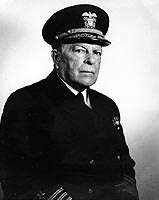William S. Pye
| William Satterlee Pye | |
|---|---|
 Vice Admiral William S. Pye, USN | |
| Born |
9 June 1880 Minneapolis, Minnesota |
| Died |
4 May 1959 (aged 78) Bethesda, Maryland |
| Place of burial | Arlington National Cemetery |
| Allegiance |
|
| Service/branch |
|
| Years of service | 1901–1945 |
| Rank |
|
| Commands held |
Acting CINCPAC Task Force 1 President of the Naval War College |
| Battles/wars |
World War I World War II |
| Awards |
Navy Cross Legion of Merit World War I Victory Medal World War II Victory Medal Spanish Campaign Medal American Defense Service Medal |
Vice Admiral William Satterlee Pye, United States Navy, (9 June 1880 – 4 May 1959) was a U.S. Navy officer who served during World War I and World War II, but never saw combat action. His last active-duty appointment was as President of the Naval War College, in 1942–1946. His awards included the Navy Cross for his distinguished service as a staff officer during World War I.
Career through World War I
Pye was born in Minneapolis, Minnesota, on 9 June 1880. Entering the United States Naval Academy in 1897, he graduated in 1901 and was commissioned an Ensign in June 1903. From 1901 through 1915, he served in several ships, among them five battleships and an armored cruiser, and was also assigned to the staffs of the Naval Academy and Naval War College. In 1915–1916 he placed the new destroyer USS Jacob Jones into commission. He relinquished command of Jacob Jones before her 1917 deployment to Europe with the US entry into World War I, and joined the staff of the Commander in Chief, Atlantic Fleet. He served in that position through the war, receiving the Navy Cross "for exceptionally distinguished and valuable service on the staff of the commander in chief, U.S. Atlantic Fleet, in addition to excellent performance of his routine staff duties in preparing a series of orders for the conduct of battleship and fleet, based upon the best thought and experience of the United States fleet and British fleet during the late war."[1]
Interwar years
Pye served in the Office of the Chief of Naval Operations in 1919–1921, and was Executive Officer of the battleship Pennsylvania in 1922–1923. After briefly commanding a destroyer squadron, he returned to Washington, D.C., for service at the Navy Department, which lasted into 1927. In the next five years, he commanded the minelayer Oglala, had more Navy Department service, and was head of the U.S. Naval Mission to Peru. Captain Pye commanded the battleship Nevada in 1932–1933.
Promoted to the rank of Rear Admiral, Pye served as Chief of Staff to Commander Scouting Force, attended the Naval War College, had further Navy Department service, and was Commander Destroyers in both the Scouting Force and Battle Force of the Pacific Fleet. With the temporary rank of Vice Admiral, he was Commander Battleships, Battle Force in 1940 and Commander Battle Force in 1941.
World War II and post-war years
He is perhaps best known for his 6 December 1941 remark that "The Japanese will not go to war with the United States. We are too big, too powerful, and too strong." Following the Japanese attack on Pearl Harbor on 7 December 1941 and the subsequent relief of Pacific Fleet Commander (CinCPACFLT) Admiral Husband E. Kimmel, Vice Admiral Pye became Acting CinCPACFLT on 17 December. He had reservations about Kimmel's plan to send a relief force including the aircraft carrier USS Saratoga to the aid of Wake Island, but continued with the plan until 22 December. Then - after reports of additional landings on Wake - Pye decided the operation was too risky and recalled the relief force. This decision was highly controversial, as it amounted to abandoning the Wake Island garrison, which had defeated a Japanese landing on 11 December.
On 31 December, Pye relinquished command of the Pacific Fleet to Admiral Chester W. Nimitz. Pye became commander of Task Force One (TF 1), comprising the remaining operational battleships in the Pacific Fleet, now based in San Francisco. During the Battle of Midway, Pye received orders for the seven old battleships (Colorado, Idaho, Maryland, Mississippi, New Mexico, Pennsylvania, and Tennessee), the escort carrier USS Long Island, and eight destroyers of TF 1 to sortie to patrol off of the West Coast against possible Japanese attack there should the carrier forces at Midway be defeated. Such fears proved unfounded, and TF 1 then remained on training and patrol duties between Hawaii and the West Coast until Pye was relieved in October 1942. He never commanded operating forces again, and was relegated to administrative positions. On 2 November, Pye became President of the Naval War College in Newport, Rhode Island, and also commanded the Naval Operating Base there. He officially retired on 1 July 1944, but was recalled to active duty as President of the War College, and promoted to permanent Vice Admiral. He continued at the War College until retiring from active duty on 1 March 1946. Pye died at Bethesda, Maryland on 4 May 1959. He is buried in Arlington National Cemetery, United States.[2]
Pye's son, Lieutenant Commander John Briscoe Pye, served on the submarine USS Swordfish on her 13th and final war patrol. Swordfish was lost with all hands on January 12, 1945, off Kyushu, Japan.
References
| Military offices | ||
|---|---|---|
| Preceded by Husband E. Kimmel |
Commander in Chief of the United States Pacific Fleet 1941 |
Succeeded by Chester W. Nimitz |
| Preceded by Edward C. Kalbfus |
President of the Naval War College 1942-1946 |
Succeeded by Raymond A. Spruance |